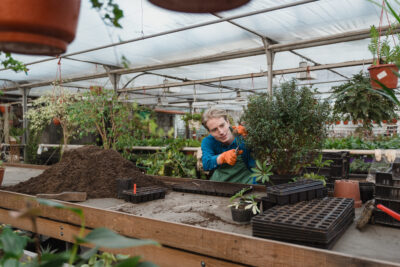
Avoid Overwatering: Tips for Healthy Succulents

Succulents have become increasingly popular in recent years as indoor and outdoor plants due to their unique and striking appearance. These plants are known for their ability to store water in their leaves, stems, and roots, making them highly adaptable to dry and arid conditions. While succulents are generally low-maintenance, one common mistake that many people make is overwatering them. Overwatering can lead to root rot, fungal diseases, and ultimately the death of the plant. In order to keep your succulents healthy and thriving, it’s important to understand their specific watering needs and how to avoid overwatering.
We will provide you with useful tips and guidelines to help you avoid overwatering your succulents. We will discuss the signs of overwatering and how to properly assess when your succulents need watering. Additionally, we will cover the best watering techniques and tools to use for succulents, as well as the importance of well-draining soil and proper pot selection. By following these tips, you will be able to provide your succulents with the optimal growing conditions and ensure their long-term health and beauty.
- Water your succulents only when the soil is completely dry
- Use a well-draining soil mix specifically designed for succulents
- Make sure your succulents are planted in pots with drainage holes
- Provide adequate sunlight for your succulents, but avoid direct, intense sunlight
- Avoid misting your succulents as this can lead to overwatering
- Use a watering schedule based on the specific needs of your succulents
- Be mindful of the time of year and adjust your watering frequency accordingly
- Monitor the growth and appearance of your succulents to determine their water needs
- Avoid using shallow containers as they can trap excess water
- Consider using a moisture meter to accurately gauge the moisture level of the soil
- Frequently Asked Questions
Water your succulents only when the soil is completely dry
One of the most common mistakes succulent owners make is overwatering. Succulents are desert plants and have adapted to survive in dry conditions. Overwatering can lead to root rot and ultimately kill your beloved succulents. Therefore, it is crucial to water them only when the soil is completely dry.
But how do you know when the soil is dry? There are a few methods you can use:
- Finger test: Stick your finger about an inch into the soil. If it feels dry, it's time to water your succulents. If it still feels moist, wait a few more days before watering.
- Weight of the pot: Lift the pot and feel its weight. If it feels light, it means the soil has dried out, and it's time to water. If it still feels heavy, hold off on watering.
- Visual cues: Look at the soil's color. Dry soil tends to be lighter in color, while damp soil appears darker. Additionally, the soil may pull away from the sides of the pot when it's dry.
Remember, succulents are built to withstand drought, and they store water in their leaves and stems. Therefore, it's better to underwater than overwater. If in doubt, it's always safer to wait a little longer before watering your succulents.
Use a well-draining soil mix specifically designed for succulents
When it comes to succulents, proper soil is crucial for their overall health and well-being. Using a well-draining soil mix specifically designed for succulents is essential to avoid overwatering. Succulents are adapted to thrive in dry conditions, so they need soil that allows excess water to escape easily.
 The Impact of Shallow Root Systems on Succulent Plants
The Impact of Shallow Root Systems on Succulent PlantsAvoid using regular potting soil or garden soil, as they tend to retain water for longer periods, which can lead to root rot and other issues. Instead, opt for a soil mix that consists of a combination of materials such as perlite, pumice, and coarse sand. This combination creates air pockets within the soil, allowing water to drain quickly.
Tip: You can either purchase a pre-made succulent soil mix from a garden center or create your own by mixing equal parts of potting soil, perlite, and coarse sand.
Make sure your succulents are planted in pots with drainage holes
Proper drainage is essential for the health of your succulents. Succulents are native to arid regions and are adapted to survive in dry conditions. They have specialized water storage tissues that allow them to store water for long periods. However, if their roots sit in waterlogged soil for too long, it can cause root rot and eventually kill the plant.
When choosing pots for your succulents, opt for ones with drainage holes at the bottom. These holes allow excess water to escape, preventing it from pooling around the roots. Avoid using pots without drainage holes or ones with saucers that collect water, as they can lead to overwatering.
Additionally, it's essential to use well-draining soil specifically designed for succulents. This type of soil is typically a mix of regular potting soil, coarse sand, and perlite. This mixture allows water to flow through the soil quickly, preventing it from becoming waterlogged.
Tips:
 Are Succulents Affected by Overwatering?
Are Succulents Affected by Overwatering?- Choose pots with drainage holes to prevent water from accumulating around the roots.
- Use well-draining soil specifically formulated for succulents.
- Avoid using pots without drainage holes or ones with saucers that collect water.
By ensuring proper drainage for your succulents, you can prevent overwatering and promote their overall health and longevity.
Provide adequate sunlight for your succulents, but avoid direct, intense sunlight
When it comes to caring for succulents, providing adequate sunlight is crucial. Succulents thrive in bright light conditions, but direct and intense sunlight can actually damage their leaves. To strike the right balance, it's best to place your succulents in an area where they can receive bright, indirect sunlight for several hours a day.
It's important to note that the lighting requirements can vary depending on the type of succulent you have. Some varieties, such as Echeverias and Sedums, can tolerate more direct sunlight, while others, like Haworthias and Gasterias, prefer slightly shadier conditions.
If you notice your succulent's leaves turning brown or scorched, it may be a sign that they are getting too much sunlight. In such cases, consider moving them to a spot with filtered light or providing them with some shade during the hottest part of the day.
Watering succulents: Less is more
One of the most common mistakes when it comes to succulent care is overwatering. Succulents are adapted to survive in arid environments, so they have evolved to store water in their leaves, stems, or roots. This means that they are more prone to damage from excess moisture rather than from dehydration.
To keep your succulents healthy, it's important to adopt a "less is more" approach when it comes to watering. Allow the soil to dry out completely between waterings, as succulents prefer a dry and well-drained growing medium. Overwatering can lead to root rot, which is often fatal for succulents.
Furthermore, it's essential to water the soil directly rather than spraying water on the leaves of succulents. Wet leaves can create a moist environment that encourages fungal diseases. Aim to water the soil thoroughly, allowing the excess water to drain away.
 Using Sphagnum Moss as a Growing Medium for Succulents: Pros and Cons
Using Sphagnum Moss as a Growing Medium for Succulents: Pros and ConsSigns of underwatering and overwatering
Understanding the signs of underwatering and overwatering can help you adjust your watering schedule accordingly. An underwatered succulent may display wrinkled or shriveled leaves and a generally dehydrated appearance. The leaves may also become yellow or dry out.
On the other hand, an overwatered succulent may have soft, mushy leaves and develop root rot. The leaves may appear translucent and feel squishy to the touch. Additionally, overwatering can cause the succulent to become leggy or elongated as it tries to reach for more light.
By paying attention to these visual cues, you can ensure that your succulents receive the right amount of water for optimal health.
Avoid misting your succulents as this can lead to overwatering
One common mistake that many succulent owners make is misting their plants. While misting may seem like a good way to provide hydration to your succulents, it can actually lead to overwatering and cause harm to these hardy plants.
Succulents are adapted to survive in arid environments, and their leaves are designed to retain water. Misting them on a regular basis can disrupt this natural process and lead to waterlogged soil.
So, how can you avoid overwatering your succulents?
 Optimal Soil for Succulents: Understanding Preferred Types
Optimal Soil for Succulents: Understanding Preferred Types- Water sparingly: Instead of misting, water your succulents sparingly. Wait until the soil is completely dry before watering again. This will help prevent overwatering and promote healthy root growth.
- Pay attention to the signs: Keep an eye on your succulents for signs of overwatering, such as yellowing or mushy leaves. If you notice these signs, it's a clear indication that you need to cut back on watering.
- Use well-draining soil: Succulents thrive in soil that drains quickly. Make sure to use a well-draining soil mix specifically formulated for succulents. This will help prevent water from pooling around the roots.
- Choose the right container: Opt for a container with drainage holes to allow excess water to escape. This will prevent water from sitting in the bottom of the container and potentially rotting the roots.
- Provide adequate sunlight: Succulents need plenty of sunlight to thrive. Make sure to place them in a location where they can receive at least six hours of direct sunlight each day. This will help the soil dry out more quickly and reduce the risk of overwatering.
By following these tips, you can ensure that your succulents stay healthy and avoid the common pitfalls of overwatering. Remember, less is more when it comes to watering these resilient plants!
Use a watering schedule based on the specific needs of your succulents
Succulents are known for their ability to store water in their leaves, stems, and roots. This adaptation allows them to survive in arid environments with little rainfall. However, despite their water-storing abilities, overwatering is a common problem that can lead to root rot and other issues.
To avoid overwatering your succulents, it's essential to develop a watering schedule based on their specific needs. Keep in mind that different succulent varieties have different water requirements. Some succulents, like Aloe vera, prefer more frequent watering, while others, like Echeveria, require less frequent watering.
To determine the watering needs of your succulents, consider factors such as the type of succulent, the size of the pot, and the climate in which you live. Research the specific requirements of each succulent variety you have and create a watering schedule accordingly.
Signs of overwatering
- Yellowing leaves: If the leaves of your succulent start turning yellow and feel soft or mushy, it's a sign of overwatering. Overwatering can cause the roots to rot, leading to nutrient deficiencies and poor plant health.
- Root rot: Inspect the roots of your succulent for signs of rotting, such as a foul smell or dark, mushy roots. Root rot is a serious condition that can be fatal for your plant if not addressed promptly.
- Mold or fungus: Overwatered soil provides a favorable environment for the growth of mold and fungus. If you notice any unusual growth on the soil surface or around the base of your succulent, it could be a sign of overwatering.
By keeping an eye out for these signs, you can quickly identify if your succulent is being overwatered and take the necessary steps to correct the issue.
Watering techniques for succulents
- Bottom watering: Instead of watering from the top, try bottom watering your succulents. Place the pot in a shallow dish filled with water and allow the plant to absorb the water through the drainage holes. This method prevents overwatering and promotes healthy root growth.
- Watering deeply but infrequently: When watering your succulents, ensure that the water penetrates the soil deeply. This encourages the roots to grow downwards in search of moisture. However, it's important not to water too frequently. Allow the soil to dry out between waterings to prevent overwatering.
- Use well-draining soil: Succulents thrive in well-draining soil that allows excess water to flow out quickly. Ensure that your potting mix is specifically formulated for succulents, or add perlite or coarse sand to improve drainage.
Following these watering techniques and paying attention to the signs of overwatering will help you keep your succulents healthy and thriving. Remember, it's better to underwater than to overwater your succulents, as they can tolerate drought conditions much better than excessive moisture.
 Can Succulents Be Submerged in Water for Extended Periods?
Can Succulents Be Submerged in Water for Extended Periods?Be mindful of the time of year and adjust your watering frequency accordingly
One of the most important aspects of succulent care is getting the watering frequency just right. Succulents are desert plants, known for their ability to store water in their leaves and stems. This adaptation allows them to survive in arid environments with little rainfall. However, it also means that they are highly susceptible to overwatering.
To ensure the health of your succulents, it is crucial to adjust your watering frequency based on the time of year and the specific needs of each plant. During the spring and summer months, when succulents are in their active growth phase, they require more water. On the other hand, during the fall and winter, when they enter a period of dormancy, their water requirements decrease significantly.
It is recommended to water your succulents thoroughly, allowing the water to soak into the soil until it reaches the roots. However, it is equally important to allow the soil to dry out completely before watering again. Overwatering can lead to root rot and other fungal diseases that can be fatal to succulents.
To determine when it's time to water your succulents, you can use the "soak and dry" method. Stick your finger about an inch into the soil; if it feels dry at that depth, it's time to water. If the soil still feels moist, it's best to wait a few more days before watering.
Remember, it's always better to underwater than to overwater your succulents. They are resilient plants and can tolerate drought conditions much better than excessive moisture. By being mindful of the time of year and adjusting your watering frequency accordingly, you can ensure that your succulents stay healthy and vibrant.
Monitor the growth and appearance of your succulents to determine their water needs
One of the most important aspects of succulent care is understanding their water needs. Succulents are known for their ability to store water in their leaves and stems, making them drought-tolerant plants. However, this doesn't mean they can survive without any water at all.
 Can Succulents Thrive in Potting Soil or Do They Require Special Care?
Can Succulents Thrive in Potting Soil or Do They Require Special Care?To avoid overwatering your succulents, it's crucial to monitor their growth and appearance. Succulents that are thriving typically have plump, firm leaves and a compact, healthy appearance. On the other hand, overwatered succulents may develop mushy, translucent leaves or become leggy and stretched out.
By regularly observing your succulents and keeping an eye out for any signs of overwatering, you can adjust your watering routine accordingly and ensure their health and longevity.
Watering frequency
One of the main reasons succulents suffer from overwatering is due to a too-frequent watering schedule. Unlike other houseplants, succulents prefer to be watered infrequently but deeply. A general rule of thumb is to water your succulents only when the top inch of soil feels completely dry.
However, it's important to note that the watering frequency may vary depending on factors such as the climate, time of year, and the type of succulent you have. Some succulents, like cacti, require even less water and can tolerate longer periods of drought.
Watering technique
When it's time to water your succulents, it's crucial to use the right watering technique. Instead of lightly sprinkling water on the topsoil, aim to thoroughly saturate the soil until water drains out from the bottom of the pot. This ensures that the water reaches the roots and encourages deep root growth.
Additionally, avoid leaving your succulents sitting in standing water, as this can lead to root rot. Always make sure to empty the drainage tray or saucer after watering.
Choosing the right potting mix
The type of potting mix you use can also affect the water retention of your succulents. It's best to use a well-draining mix specifically designed for succulents and cacti. These mixes typically contain a combination of materials like perlite, pumice, or coarse sand, which improve drainage and prevent water from sitting around the roots.
 Find the Best Soil for Your Succulents with Eb Stone
Find the Best Soil for Your Succulents with Eb StoneAvoid using regular potting soil or mixes that retain moisture for too long, as this can lead to overwatering and root rot.
Remember: Succulents are adapted to survive in arid environments, so it's better to underwater than to overwater them. By closely monitoring their growth, adjusting your watering schedule, using the right technique, and choosing the appropriate potting mix, you can ensure the health and longevity of your succulents.
Avoid using shallow containers as they can trap excess water
When it comes to succulent care, one of the most important factors to consider is proper watering. Overwatering is a common mistake that can lead to root rot and the death of your beloved succulents. To ensure the health and longevity of your plants, it's crucial to avoid using shallow containers that can trap excess water.
Shallow containers may seem like a trendy choice for displaying succulents, but they can be detrimental to their well-being. These containers have a limited amount of space for soil, which means there is less room for proper drainage. As a result, water can easily accumulate at the bottom, saturating the roots and causing them to rot.
To prevent this issue, opt for containers that are deep enough to provide ample space for the succulent's root system. A depth of at least 2-3 inches is recommended to allow for proper drainage. This will ensure that excess water can escape freely and won't linger around the roots.
In addition to the container depth, it's also essential to consider the type of soil you use. Succulents thrive in well-draining soil that allows water to flow through easily. You can create a suitable mix by combining regular potting soil with perlite, pumice, or coarse sand. These additives will enhance the drainage capacity of the soil and prevent water from pooling at the bottom of the container.
 The Soak and Dry Method for Succulents: A Comprehensive Guide
The Soak and Dry Method for Succulents: A Comprehensive GuideWhen watering your succulents, always remember the "soak and dry" method. This means thoroughly saturating the soil and then allowing it to dry out completely before watering again. Succulents are adapted to withstand periods of drought, and this watering technique mimics their natural habitat.
Lastly, it's important to take into account the environmental conditions in which your succulents are placed. Factors such as temperature, humidity, and sunlight can affect the watering needs of your plants. For instance, succulents placed in a hot and sunny location will require more frequent watering compared to those in a cooler and shadier spot.
By avoiding shallow containers and following these watering tips, you can ensure the health and vitality of your succulents. Remember, it's always better to underwater than to overwater, as succulents are more tolerant of dry conditions than excessive moisture. Happy succulent growing!
Consider using a moisture meter to accurately gauge the moisture level of the soil
One of the biggest mistakes succulent owners make is overwatering their plants. Succulents are adapted to survive in arid conditions, which means they store water in their leaves, stems, and roots. Overwatering can lead to root rot and ultimately kill the plant. To avoid this, it's important to have a reliable method of measuring the moisture level in the soil.
One useful tool for succulent owners is a moisture meter. This device allows you to accurately measure the moisture content in the soil, ensuring you don't overwater your plants. Simply insert the probe of the moisture meter into the soil, and it will provide you with a reading.
When using a moisture meter, it's important to understand the ideal moisture level for succulents. Most succulents prefer soil that is slightly dry before watering again. The moisture meter will indicate whether the soil is dry, moist, or wet. Aim to water your succulents when the meter indicates that the soil is dry or slightly moist.
 Where to Find Succulent Soil at Home Depot: Your Guide to Buying
Where to Find Succulent Soil at Home Depot: Your Guide to BuyingBy using a moisture meter, you can take the guesswork out of watering your succulents. This will help you maintain the ideal moisture balance and prevent overwatering, which is crucial for the health and longevity of your plants.
Frequently Asked Questions
1. How often should I water my succulents?
Succulents are drought-tolerant plants, so they should only be watered when the soil is completely dry. Generally, this means watering once every 1-2 weeks.
2. Can I use a spray bottle to water my succulents?
While using a spray bottle may seem convenient, it's not the best method for watering succulents. It is more effective to thoroughly soak the soil until water drains out of the bottom of the pot.
3. What type of soil is best for succulents?
Succulents thrive in well-draining soil that allows excess water to flow out. Use a mix of potting soil, perlite, and sand for optimal drainage and aeration.
4. How do I know if I am overwatering my succulents?
If the leaves of your succulents start turning yellow and mushy or if you notice root rot, it is a sign of overwatering. Remember to let the soil dry out completely between watering to avoid this issue.
If you want to read more articles similar to Avoid Overwatering: Tips for Healthy Succulents, you can visit the Watering and Soil category.






You Must Read